Experts and the Quest for Dietary Culture
- TOP
- ESSAYS
- Experts and the Quest for Dietary Culture
- The Popular Edo Dish of Soba (Autumn)
The Popular Edo Dish of Soba (Autumn)
by Hayashi Ayano
Soba as a Popular Edo Dish
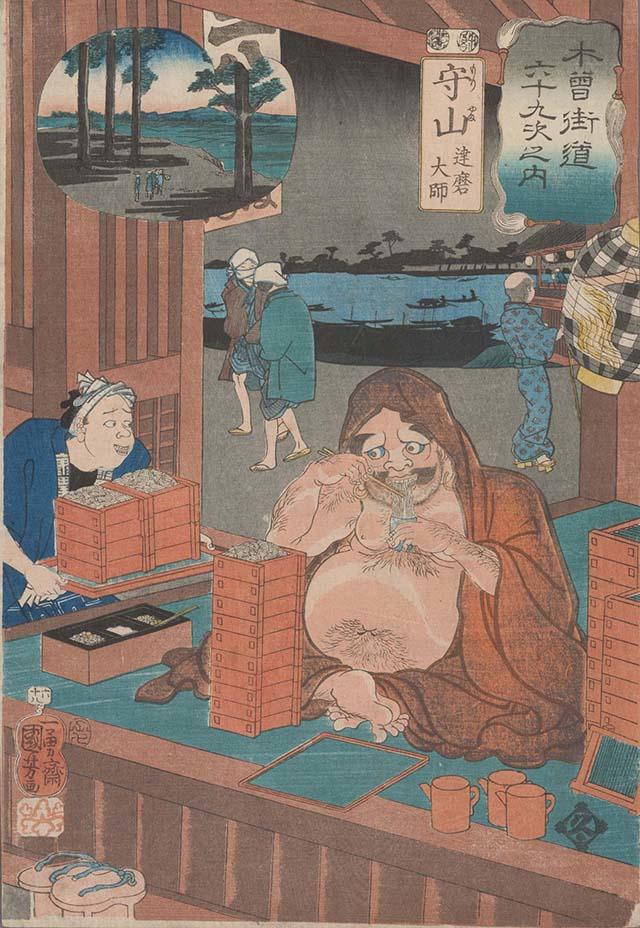
Take a close look at this picture of Bodhidarma slurping soba (buckwheat flour) noodles with a grin on his face. The man bringing him extra steamed baskets while pulling up his eyebrows with a wry smile truly looks dumbfounded. This ukiyo-e print was drawn by Utagawa Kuniyoshi (1798-1861) and is part of his series The Sixty-nine Stations of the Kiso Road (1835-1837). The series introduces the surroundings and products of a famous place found along the Kiso Road, a major route connecting Edo (now Tokyo) and Kyoto. Skillfully adding fictive characters from stories and legends to his images through word play, Kuniyoshi ingeniously depicts all the stations along the Kiso Road.
The stage for this print is Moriyama in Shiga Prefecture. When carefully looking behind the small frame in the upper part of the print above Lake Biwa, the words nihachi (two and eight) appear on a signboard. Bodhidharma is the founder of Zen Buddhism in China, and known as the twenty-eighth generation of pupils who learned from Shakyamuni, the founder of Buddhism, he is eating nihachi (two and eight, or 28) soba. The fact that the soba is sold out, indicated by restaurant staff, with the word 'yama', also forms a pun with the name of the location of the restaurant depicted here: Moriyama in Omi province (now Shiga prefecture). While including all kinds of wordplay, the background of his print also depicts a lively evening in Moriyama by Lake Biwa.
It is said that the style of eating soba from steamed baskets that Bodhidharma eats in this picture dates back to the Edo Period (1603-1868). Before that, soba was often consumed as dumplings. The soba noodles seen in this picture were referred to as cut soba. Ryōri monogatari (The Story of Food, published in the 8th year of An'ei (1643), is the first book that introduced cut soba in a section dedicated to food) made with soup stock.
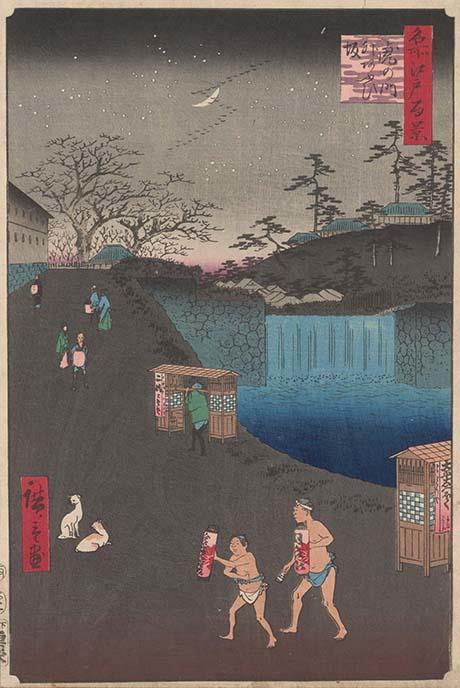
One Hundred Famous Views of Edo: Outside Toranomon, by Utagawa Hiroshige (1857)
View of Toranomon Gate lit by a clear spring moon. Along the road a man carries a food stand selling nihachi soba. A food stand with a sign advertising soba and udon with sea food can also be seen on the right side of the picture.
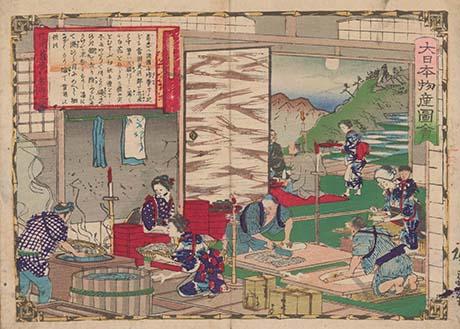
Illustrated Guide to Famous Products in Greater Japan: Soba Production and Cutting in Shinshū, by Utagawa Hiroshige III (1877)
This series introduces famous products from various regions. Soba production, cutting and kneading, as well as two men consuming soba are depicted in this image.
Preparing soba with soy sauce first became popular in Shimosa Province (now Chiba and Ibaraki prefectures) in the nineteenth century. The spread of soy sauce had a big impact on Edo food culture. It made soba dipped in soy sauce an enormously popular dish. In a series of publications titled Morisada Mankō (Sketches by Morisada), published from the Bunka (1804-1818) to the Tenpō Era (1830-1844), the author Kitagawa Morisada writes: 「At least one soba vendor regularly appears at the first and second ward of Edo.」 As seen in the print 'Outside Toranomon Gate', from the series One Hundred Famous Views of Edo by Utagawa Hiroshige (1797-1858), soba street vendors regularly stalled out in the city, revealing how much the people of Edo must have loved soba.
Soba along the Way
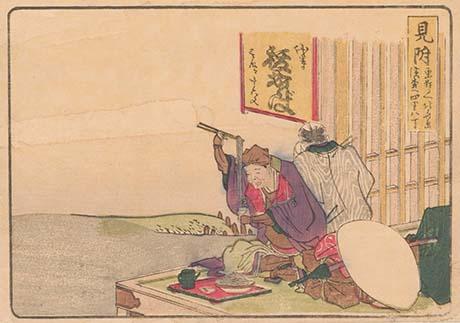
Mitsuke, by Katsushika Hokusai (1804)
Mitsuke has been known as a famous place for soba since the mid-17th century. Shops in Mitsuke are first described in a text called Record of The East Sea Route, which was published between 1658 and 1661.
During the Edo period, many people traveled along the Eastern Sea Route to worship at Ise Grand Shrine. In comical serialized novels such as Tōkaidōchū Hizakurige (Shank's Mare, 1802-1822) by Jippensha Ikku (1765-1831), the contemporary lust for travel with ordinary people takes main stage. Travel soon also becomes a major theme in ukiyo-e, with the appearance of pictures of famous places. Mitsuke by Katsushika Hokusai (1760-1849) is one of these pictures of famous places. This image depicts a town called Mitsuke located near Iwata City in Shizuoka prefecture today, which was known for delicious soba. In the upper part of the print, the signboard reads 'hikinuki soba'. This soba was refined, high quality white flour soba, and it was known all along the Eastern Sea Route. Travelers passing the mountains and rivers of the Eastern Sea Route must have said: 「if we go a bit faster we can eat delicious soba at Mitsuke」, and felt stimulated to go a little bit faster.
Hokusai's picture depicts a traveler lifting his chopstick while staring at his cup in full concentration. If you look carefully, you can see another traveler sitting behind him holding chopsticks in his right hand. On a clear day, you could see Mount Fuji from Mitsuke. Hokusai has not depicted Mount Fuji in this image, but you can easily imagine the mountain looking over the man's back.
The Origins of Asakusa Nori
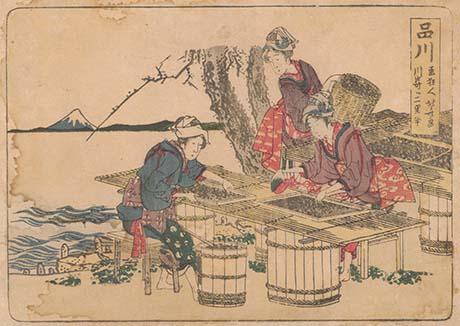
Shinagawa, by Katsushika Hokusai (1804)
For travelers who left Edo from Nihonbashi, Shinagawa was the first place they stayed the night along the East Sea Route. Asakusa nori, which was sold at Asakusa, but collected at Shinagawa, remained a popular product until the end of the Edo period.
When autumn arrives, all kinds of food come into season. Fresh soba is prepared in both spring and autumn nowadays, but in the Edo period soba was prepared in autumn. Together with fruits and grains, nori was also collected in this season.
In Hokusai's image of Shinagawa in his series of the Eastern Sea Route, women prepare seaweed in wooden boxes. After drying nori seaweed for only a day, the aroma becomes very strong, making it ready for consumption. In Edo Asakusa nori was famous, it was a popular brand name used to sell the nori, while the nori was in fact collected at Shinagawa.
Comparing the seaside landscape overlooking Mt. Fuji from Hokusai's print with Shinagawa today, it becomes clear that Shinagawa has changed a great deal. Hokusai has depicted the women chatting during work in a cheerful manner. For the people traveling eastwards along the Eastern Sea Route, Shinagawa was the first inn after leaving Edo. Here travelers would look over Edo Bay in melancholy before setting off on a long trip.
Enjoying Edo Nori Recipes
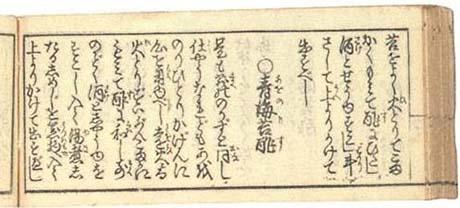
Shirōto hōchō (An Amateur Cooking Guide) by Asano Kōzō
This book was published in three parts. The first part appeared in 1803, the second in 1805, and the third in 1820. As the author notes in the book himself, this publication was aimed at a general audience.
When looking at Edo period cookbooks, many nori recipes, such as food with nori wrapping are introduced. In Ryōri haya shinan (Quick Guidance for Cooking, 1804), a nori recipe with rice can be found, and in Asano Kōzō's Shirōto hōchō (An Amateur Cooking Guide), two recipes with nori and vinegar are introduced. 'Nori with rice' is a simple recipe in which rice is boiled, strips of nori are added and then mixed together. It is important to roast the nori and cut it fine, and it is emphasized that you should boil the rice hard. Nowadays, roasted nori is common, but in Hokusai's time seasoning was generally the final step in preparing nori. People would squeeze out the moisture of nori to strengthen the aroma and eat it.
Nori with vinegar only requires you to knead and mix the nori with vinegar. After this you only need to add a bit of vinegar and soy sauce. As an autumn recipe, green nori with vinegar is mixed with shimeji mushrooms. When you try this recipe, the sour taste and aroma of nori come out, and combined with the texture of shimeji mushrooms it is a pleasant flavor.
As dishes that appear in ukiyo-e prints, soba and nori should be considered true Edo food. They are not complex but rich in taste, and through daily consumption the people of Edo became familiar with these dishes. Within that simply flavor of Edo food, different aroma and food textures can be discovered, and in their daily enjoyment of the plain taste of soba and nori, we can recognize the true character of Edo's people.
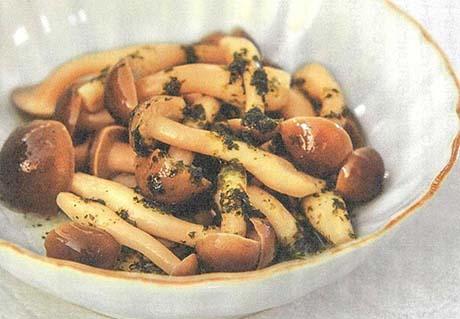
©Akio Takeuchi
Shimeji Mushrooms with Nori and Vinegar Dressing
Ingredients
Shimeji mushrooms ...... 100-200g
Chopped nori ...... proper amount
Vinegar ...... proper amount
Dashi cooking stock ...... 1 cup (200 ml)
Sake ...... two large spoons (30 ml)
Soy sauce ...... two small spoons (10 ml)
1. Mix the nori and vinegar
2. Put the dashi cooking stock in a pan, then add sake and soy sauce
3. Let no. 2 boil for 3 minutes
4. Cool down no.3, put it in a bowl and add the mix of no. 1

